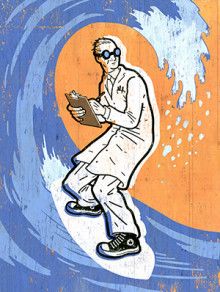Gazing at the iconic 19th-century Japanese woodcut known as “The Great Wave off Kanagawa,” one would hardly suspect it contains a key to a medical breakthrough. Yet the pigment in the artwork has opened a new perspective in the treatment of juvenile cancer.
The artist, Hokusai, used Prussian blue pigment in his masterpiece. By combining the same deep blue nanoparticles with an immunotherapy class called checkpoint inhibitors, researchers have engineered a “nanoimmunotherapy” for treating neuroblastoma, a leading cause of cancer-related death among children. The nanoparticles are administered to neuroblastoma tumors where they are activated with near infrared light. The light activation causes the nanoparticles to heat and destroy tumor tissue and elicit a robust anti-tumor response from the immune system. These anti-tumor effects are made more potent by the administration of the checkpoint inhibitor treatment.

Nanoimmunology, as the field is called, is really the synthesis of nanotechnology and immunotherapy — a marriage of engineering and medicine. Nano is the science of tiny, explains Rohan Fernandes, PhD, the leader of a team in the George Washington University (GW) Cancer Center that is integrating nano science with the immune response. “Nanoimmunology takes these tiny particles that can interact with the immune system to elicit a robust response for any therapeutic purpose, whether it be infections or cancer,” says Fernandes, who also serves as assistant professor of medicine at the GW School of Medicine and Health Sciences (SMHS). How small are nanoparticles? The particles are measured in nanometers, or one billionth of a meter. Nanotechnology is concerned with the use and control of structures that range from one to 100 nanometers in size. Fernandes, 39, is an engineer by training who earned his PhD in bioengineering from the University of Maryland. After a fellowship at Johns Hopkins University, he came under the mentorship of Catherine Bollard, MD, associate center director for translational research and innovation at GW Cancer Center, and professor of pediatrics and of microbiology, immunology, and tropical medicine at SMHS. Fernandes joined the GW Cancer Center last December. “I thought my field (of nanotechnology) would be useful for immunology,” says Fernandes, adding that the science “is actually the dynamic interplay between the nano world and the immunotherapy world.” Over his career, Fernandes saw a lot of neuroblastomas. As a grad student, he’d become familiar with the story of Alexandra “Alex” Scott who, after being diagnosed with neuroblastoma before her first birthday, set up a front-yard lemonade stand to raise money for research. A year after Alex died in 2004, her parents started the Alex’s Lemonade Stand Foundation. “Alex’s courageous struggle was one of the motivations to undertake research that is more translational,” he explains. In January 2018, Fernandes and his team received more than $700,000 from the foundation for neuroblastoma research. The research is focused on what Fernandes calls “nanoimmunotherapy,” which leverages the properties of nanoparticles with checkpoint inhibitors to treat neuroblastoma. The nanoparticles are sent to battle neuroblastoma tumors spurred on by near infrared light. Once activated, the nanoparticles heat and destroy tumor tissue and cause the immune system to deliver a robust anti-tumor response. Checkpoint inhibitors are molecules that block immune checkpoints, which are receptors or ligands that modulate the immune response. In a lot of cancers, tumor cells express these checkpoints to “hide” from the immune system. Blocking the immune checkpoint “releases the brakes” on the immune system. “We try to break up the tumor so that the tumor cells are killed by the nanoparticles, and in doing so we present the dying tumor cells to the immune system,” Fernandes explains. “Simultaneously, we take the brakes off the immune system, which recognizes the tumor cells, so the immune system can go after what we want.” Nanoparticles are made of metallic polymers that absorb the near infrared light and dissipate the resulting energy into heat through a process known as “photothermal conversion.” This process helps limit the effect on healthy cells. “We get the majority of the tumor but there will be collateral damage to some surrounding tissue,” says Fernandes. In a newly published paper by the team led by Fernandes, researchers describe a technique using temperature control to turn immunotherapy on or off in a tumor environment. “When temperatures are at 60 degrees, the tumors are not immunogenic, meaning that the immune response cannot recognize the nanoparticles,” reports Juliana Caro-Mejia, a University of Maryland bioengineering PhD candidate. “With the heat varying in a window of 60 to 65 degrees, the tumor cells are expressing immunogenic markers. Finding this window was very exciting!” The process has already been tested on mice. The results to date indicate that treatment can boost long-term survival by 50 percent in the treated animals. Testing on humans is not imminent, however. “The Food and Drug Administration is very stringent about allowing pediatric trials,” says Fernandes. His goal is to get into clinical trials within the decade.



